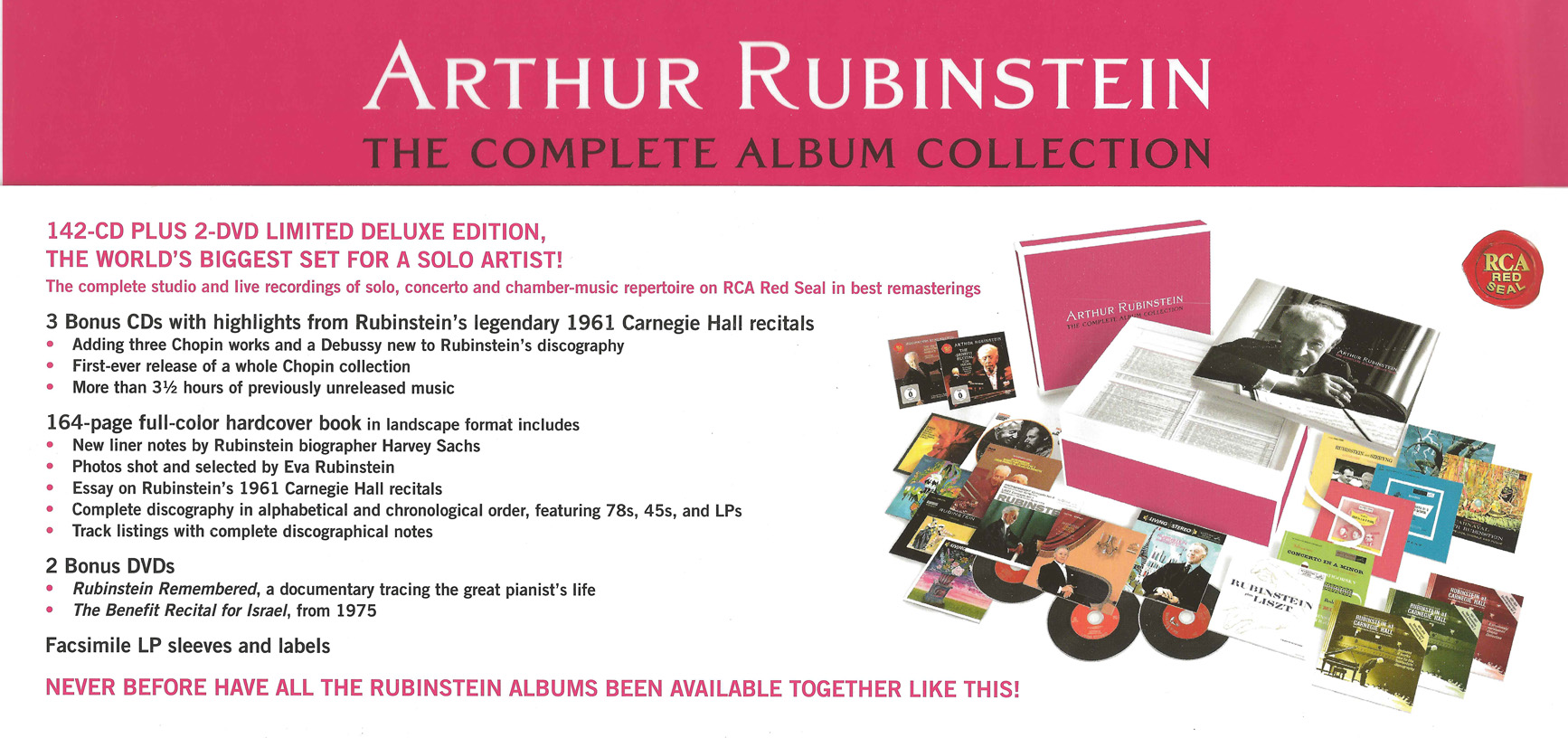Sergei Prokofiev: Visions Fugitives, op.22
Pyotr Ilyich Tchaikovsky: The Seasons, op.37a
Media Review / Listening Diary 2014-05-01
2014-05-01 — Original posting (on Blogger)
2014-11-11 — Re-posting as is (WordPress)
2016-07-20 — Brushed up for better readability
Table of Contents
Exploring the Fringes of Rubinstein’s Recording Repertoire…
Arthur Rubinstein Playing Prokofiev
The first part of this post is about music by Sergei Prokofiev (1891 – 1953). It’s a very small portion in Arthur Rubinstein’s recording history, and more accidental than systematic. These CDs are a part of the recent collection “Arthur Rubinstein — The Complete Album Collection“:
Sergei Prokofiev: March from the Opera “The Love for Three Oranges”, op.33
Arthur Rubinstein Collection, CD #77
Arthur Rubinstein — The Complete Album Collection
CD #77: Grieg: Piano concerto; Favorite Encores
Arthur Rubinstein
Alfred Wallenstein, RCA Victor Symphony Orchestra
SONY Classical 88691936912 (142 CDs / 2 DVDs, mono / stereo); ℗ / © 2011
Documentation 162 pp., track listing on CD sleeve

1961 saw the release of an LP featuring Edvard Grieg’s piano concerto and Rubinstein’s “favorite encores”. This included one single composition by Sergei Sergejewitch Prokofjew (1891 – 1953). It’s actually not “proper Prokofiev”, but Arthur Rubinstein’s own piano arrangement of the popular March from Prokofiev’s opera “The Love for Three Oranges”, op.33. This is just a short piece of just 1’40” duration. Rubinstein “arranged it into his own hands”, and so of course plays this very well. It’s certainly very effective as a (last) encore—a piece that the artist could pull out of his sleeve at any time, any day!
Sergei Prokofiev: Visions Fugitives, op.22
Arthur Rubinstein Collection, CD #78
Arthur Rubinstein — The Complete Album Collection
CD #78: Rubinstein at Carnegie Hall
Debussy: 4 pieces; Szymanowski: 4 Mazurkas; Prokofiev: Visions fugitives; Villa-Lobos: 6 pieces from “Prole do bebê Nr.1”
SONY Classical 88691936912 (142 CDs / 2 DVDs, mono / stereo); ℗ / © 2011
Documentation 162 pp., track listing on CD sleeve

Prokofiev composed the Visions fugitives, op.22 in 1915 – 1917. They include 20 short movements. In the list below, the subset which Rubinstein selected is shown in bold. In Rubinstein’s recorded output, this music only survived as a concert recording (Carnegie Hall, 1961-11-06). This indicates that the artist did not consider this a core part of his repertoire.
- Lentamente
- Andante
- Allegretto
- Animato
- Molto giocoso
- Con eleganza
- Pittoresco (Arpa)
- Comodo
- Allegro tranquillo
- Ridicolosamente
- Con vivacità
- Assai moderato
- Allegretto
- Feroce
- Inquieto
- Dolente
- Poetico
- Con una dolce lentezza
- Presto agitatissimo e molto accentuato
- Lento irrealmente
The Recorded Subset in Playing Order
We don’t know why he only selected a subset of the 20 pieces. Did he just take the ones he liked most? For “just a concert” (as opposed to a studio recording) there is no compelling need to play the complete set. Rubinstein arranged the 12 selected pieces such that he obtained a “sensible dramaturgy”:
- Lentamente (1’08”)
- Andante (1’26”)
- Allegretto (0’55”)
- Assai moderato 1’04”)
- Con eleganza (0’26”)
- Pittoresco (1’43”)
- Ridicolosamente (0’41”)
- Con vivacità (1’03”)
- Con una dolce lentezza (1’02”)
- Allegro tranquillo (0’57”)
- Dolente (1’43”)
- Feroce (0’57”)
These pieces are still partly tonal. Prokofiev himself premiered them in 1918. Some remind me of episodes from “Peter and the Wolf”. They are entertaining and pretty easy to listen to. OK, after all, 12 pieces in 13 minutes can hardly be boring! I should probably look for a complete recording with all 20 Visions fugitives!?
Vladimir Ashkenazy — Pyotr Ilyich Tchaikovsky: The Seasons, op.37a
Tchaikovsky: The Seasons, op.37a; 5 pieces for piano
Decca 466 562-2 (CD, stereo); ℗ / © 1999
Booklet: 16 pp. (e/f/d)

This is a CD I bought out of curiosity, and now I’m not really sure whether the music was worth it!
Addendum 2016-07-20: having heard this music in concert a few times resolved this point / question: it’s very nice music, indeed! See the following concert reviews from
- 2015-11-27 (Denis Matsuev, piano recital at Zurich Tonhalle),
- 2016-03-08 (Olga Scheps, piano recital at Zurich Tonhalle), and
- 2016-07-01 (Boris Berezovsky, piano recital in Vevey).
The Composition
For Pyotr Ilyich Tchaikovsky (1840 – 1893), piano works were more of a diversion from his “big projects”. He did not invest much effort into writing music for piano solo. The most well-known piano work is probably his Piano Sonata in G major, op.37. The bulk of his other output for piano solo are short character pieces. The most well-known among these appeared as “Les Saisons” (The Seasons), op.37a. It’s a sequence of 12 mostly unpretentious pieces, one for each month of the year. Some people more appropriately refer to the series as “The Months”. Note that “Les Saisons” is sometimes also referred to as op.37b rather than op.37a (both make it sound like an appendix to the Piano Sonata!).
The Movements and Their Annotation
- Janvier: Au coin du feu (January: At the fireside, 5’10”)
- Février: Carnaval (February: Carnival, 2’35”)
- Mars: Chant de l’alouette (March: Song of the lark, 2’53”)
- Avril: Perce-neige (April: Snowdrop, 2’40”)
- Mai: Les nuits de mai (May: Starlight nights, 4’50”)
- Juin: Barcarolle (June: Barcarolle, 5’26”)
- Juillet: Chant du faucheur (July: Song of the reaper, 1’42”)
- Août: La moisson (August: Harvest song, 3’05”)
- Septembre: La chasse (September: Hunting song, 2’27”)
- Octobre: Chant d’automne (October: Autumn song, 5’17”)
- Novembre: Troïka (November: Troika, 2’57”)
- Décembre: Noël (December: Christmas, 4’20”)
Movements, Description
All 12 pieces use the same ternary A-B-A’ structure. The CD booklet calls No.1 (January) and No.6 (June) the finest ones:
- I agree that “January” is a nice piece. The theme in the “A” part reminds me of the “Kinderszenen”, op.15, by Robert Schumann, but of course without the underlying “poetic program”. The “B” part is closer to Chopin.
- Movement No.6, the “Barcarolle“, is certainly nice as well. Just don’t expect anything even remotely resembling the famous Barcarolle op.60 by Frédéric Chopin. I don’t see the connection to “Barcarolle” in Tchaikovsky’s piece, i.e., to me, it does not evoke the picture of a boat floating on water.
In general (No.1 and No.6 excluded), I find Tchaikovsky’s lyrical, melancholic movements (in op.34a) less attractive. Still, they are based on nice melodic inventions. To me, the most attractive parts are the fast movements. Examples are No.2 (Carnival), No.7 (Song of the reaper), No.8 (Harvest song), especially No.9 (Hunting song), and No.11 (Troika). For me, the last one, No.12 (Christmas), anticipates scenes from the ballet “The Nutcracker”, op.71, from 1892.
Additional Pieces on the Same CD
The above CD includes five additional, short pieces by the same composer:
Aveu passionné
“Aveu passionné” in E minor (Moderato mosso, molto rubato, 3’08”)
The “Aveu passionné” is an arrangement from a movement of the Symphonic Ballad “The Voyevoda“, op.78.
Polka peu dansante from “6 Morceaux”, op.51
- Polka peu dansante (Allegro moderato, B minor, 4’46”)
3 Pieces from “18 Morceaux”, op.72
- Berceuse (Andante mosso, A♭ major, 6’37”)
- Tendres reproches (Allegro non tanto ed agitato, C♯ minor, 3’18”)
- Méditation (Andante mosso, D major, 5’29”)
For me, the real highlights of this CD are the three pieces from op.72, especially the Berceuse (No.2) and the Méditation (No.5). The music is very nice, indeed! I think that these two beat op.37a in musical and emotional content. OK, also here, I find myself revising that first opinion, see also the note above!
On the Artist
Vladimir Ashkenazy has recorded this music in September and December 1998, in Athens and London. Ashkenazy captures the spirit and the mood of these piano pieces very well. Let me just add one (moderately) critical remark: in the faster, more virtuosic pieces, the articulation feels rather mellow. I have nothing against the occasional, controlled and targeted arpeggiando playing. But Tchaikovsky’s piano music is often mellow enough, particularly in the lyrical parts in “The Seasons”. In my opinion, a little more conciseness would not have hurt, I think. This music does not need any extra romanticism.
The recording served as soundtrack for the 1999 drama film “The Cherry Orchard” by Mihalis Kakogiannis. The film is based on the 1904 play “The Cherry Orchard” by Anton Chekhov. I do not imply that the film served as excuse or as the sole motivation for recording this music!
Listening Diary Posts, Overview








